Key takeaways:
- Multi-signature wallets enhance security by requiring multiple keys for transaction authorization, promoting accountability in shared financial management.
- The setup of multi-signature wallets can be tailored (e.g., 2-of-3, 3-of-5 configurations), offering flexibility and fostering collaboration during financial decision-making.
- Common mistakes include overcomplicating setups, neglecting security updates, and poor communication among users, which can lead to access issues and confusion.
- Real-life experiences highlight the importance of selecting trusted co-signers and having contingency plans to manage unexpected issues effectively.
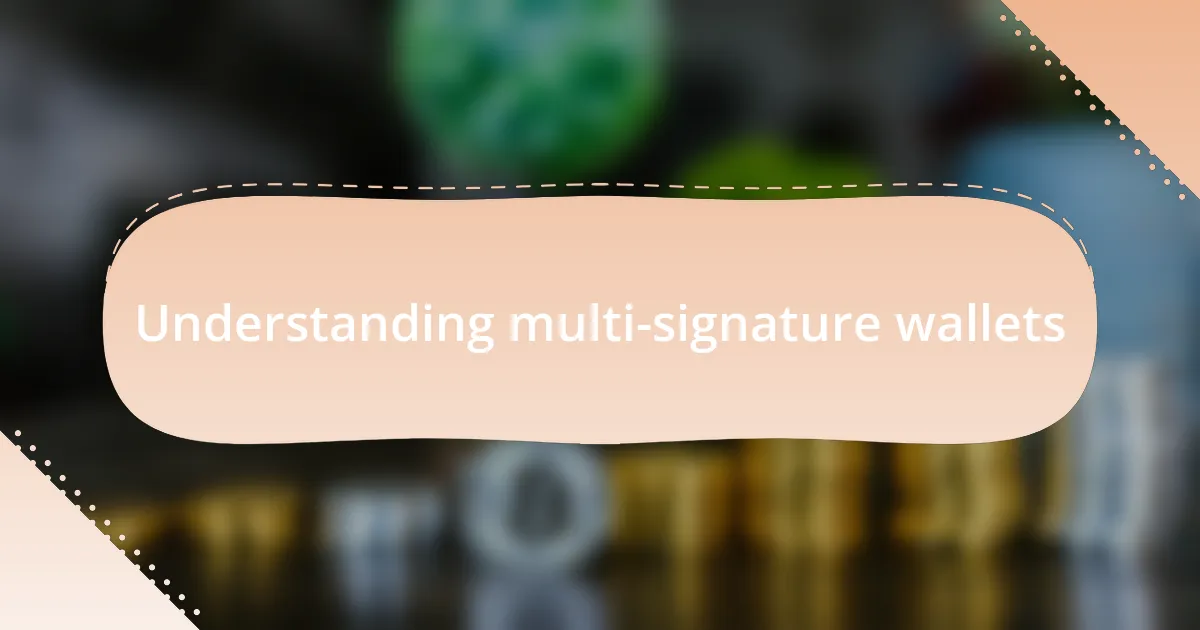
Understanding multi-signature wallets
Multi-signature wallets, often referred to as multisig wallets, require multiple private keys to authorize a transaction. This feature enhances security by making it more difficult for a single party to access funds without the consent of others involved. From my experience, I find this setup particularly valuable for organizations or groups managing shared funds, as it promotes accountability.
I remember the first time I used a multi-signature wallet for a small investment club. We each held one key, which not only secured our assets but also turned every transaction into a discussion. Have you ever had to consult a team before making a financial decision? This collaborative approach made us feel more connected and responsible for our collective choices.
In essence, the beauty of multi-signature wallets lies in their ability to balance security and collaboration. They can be set up with various configurations, such as 2-of-3 or 3-of-5, which provide flexibility based on the group’s needs. Have you considered how different setups can affect your level of security and convenience? For me, this versatility is what makes multisig solutions so intriguing in today’s digital landscape.
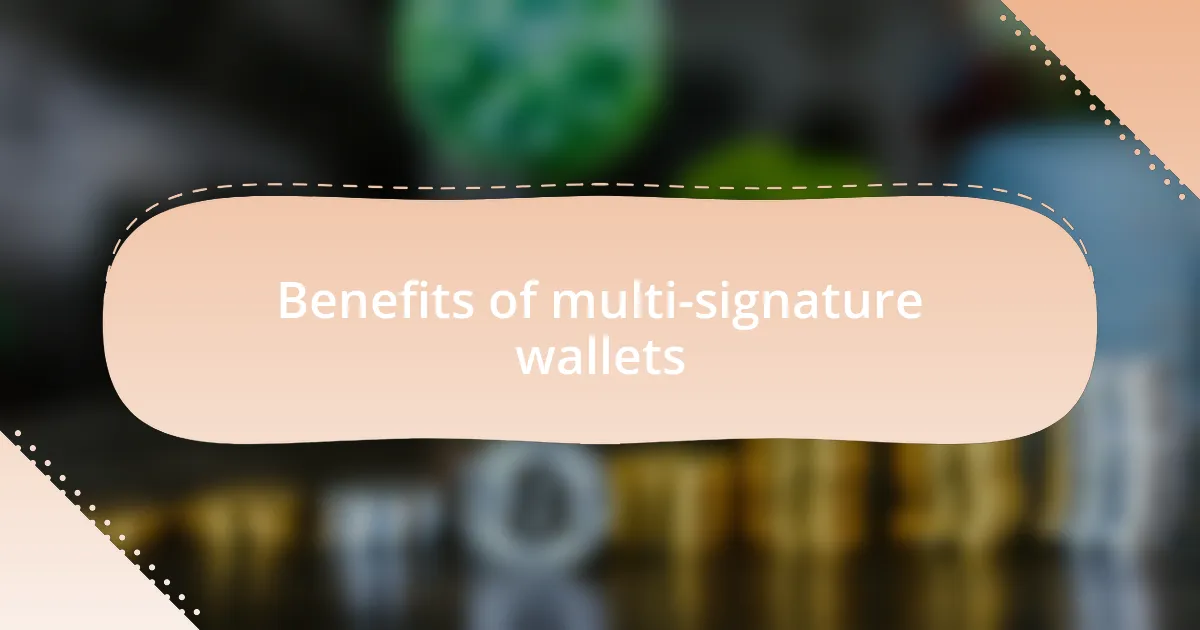
Benefits of multi-signature wallets
One of the standout benefits of multi-signature wallets is their enhanced security against theft and fraud. In my early days of investing, I once lost a significant amount due to a hacked wallet. The thought of multiple keys adds a layer of protection that simply wasn’t there before. Have you ever felt a moment of dread when you realized how vulnerable your assets could be? With multisig, knowing that several approvals are needed before any funds can be accessed gives me peace of mind.
Another major advantage is the reduction of internal fraud. When I managed a small charity fund, we used a multi-signature wallet, ensuring that no single person could misappropriate funds. It was thrilling to see that everyone involved could monitor transactions, fostering trust and transparency. Have you considered how easily trust can erode in financial situations? In our experience, the multisig setup transformed our approach to handling shared resources, reinforcing accountability among us.
Additionally, these wallets facilitate better decision-making processes. I remember discussions we had over transaction approvals; it turned routine transfers into strategic conversations. Have you thought about how collaborative financial decision-making can empower a group? That element of involvement not only solidified our commitment but also made financial management a collective learning journey. Multi-signature wallets, indeed, bring a unique blend of security and teamwork that is hard to beat.
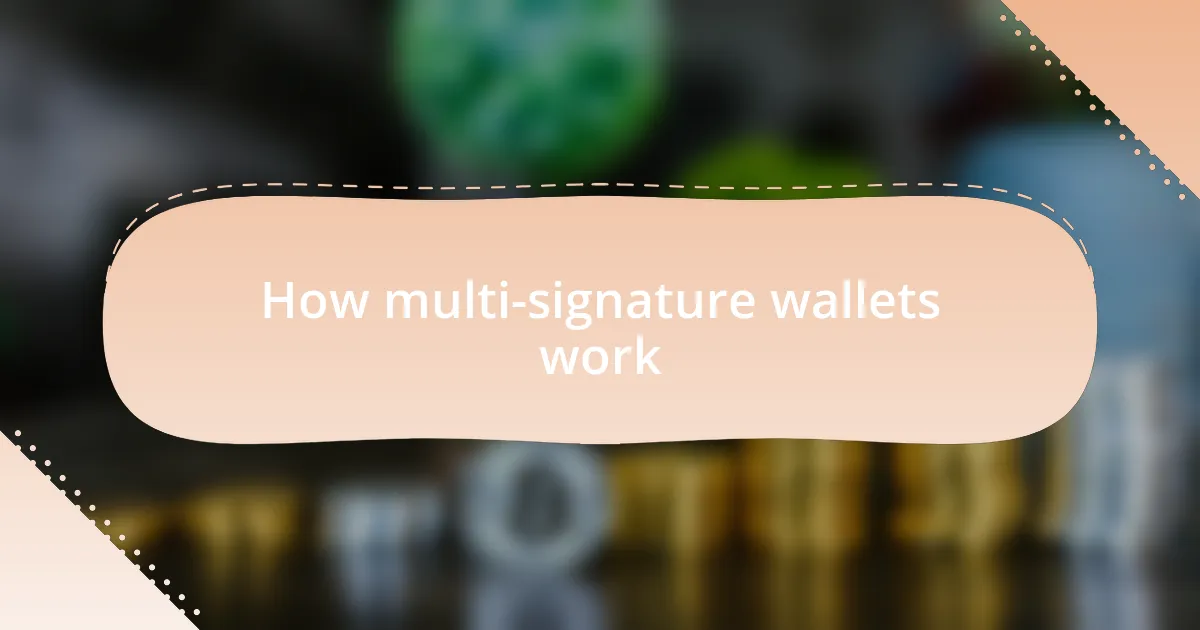
How multi-signature wallets work
Multi-signature wallets operate by requiring multiple keys or signatures to authorize a transaction. I remember feeling astounded the first time I set one up—it was like creating a digital vault where each partner held a piece of the puzzle. Have you thought about how much safer that feels compared to a single key? The distribution of control mitigates risks, as no one person can act independently without the consensus of others.
The inner workings involve setting a specific threshold for signatures that must be obtained before a transaction can go through. For instance, in my experience with a collaborative investment group, we opted for a 3-of-5 configuration. This meant that three out of five people needed to approve any withdrawal or transaction. It was fascinating to see how this requirement fostered deeper discussions about our investment choices. Have you ever realized how collective input can sharpen decision-making? The pressure of needing multiple approvals encourages thorough vetting of each transaction.
Moreover, these wallets can be customized to fit particular needs, allowing users to tailor their security strategy. After we decided to enhance our initial setup by adding a time-lock feature, it changed the dynamics completely. We could set deadlines for approvals, which added an extra layer of deliberation before any funds could move. Have you considered how vital timing can be in finance? This adaptability made our multi-signature wallet not just a tool for security, but a thoughtful approach to managing our assets together.
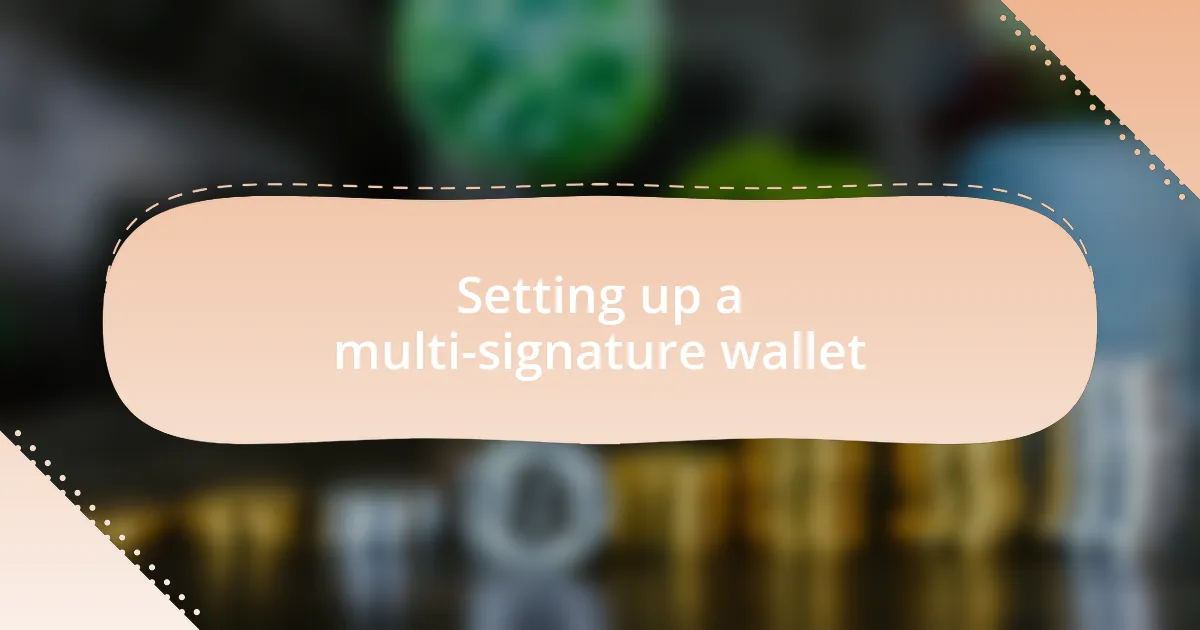
Setting up a multi-signature wallet
Setting up a multi-signature wallet isn’t as daunting as it might seem. I still remember the first time I navigated the setup process; it felt like assembling a team of guardians for my cryptocurrency. You typically begin by selecting a wallet provider that supports multi-signature functionality, which is vital. Have you considered the importance of choosing the right platform? The right provider can make a world of difference in ease of use and security.
Once you’ve chosen your provider, you’ll define your configuration—how many signatures are needed for transactions. I opted for a 2-of-3 setup for a group project, which felt like a balance between security and accessibility. It was an insightful moment to realize that empowerment in decision-making comes through shared responsibility. Beyond just sharing keys, I found that it brought a sense of camaraderie amongst us. Have you ever participated in a decision that required collective agreement? It heightens accountability.
After setting up the wallet and sharing the keys with the participants, you can start exploring features like time-locks or thresholds. When I introduced these concepts to my group, there was a noticeable shift in how we approached our finances. It opened a dialogue about long-term objectives and security, making the experience more enriching. How does the idea of shared responsibility resonate with your own experiences in financial management? Making this collaborative can truly transform your approach to cryptocurrency management.
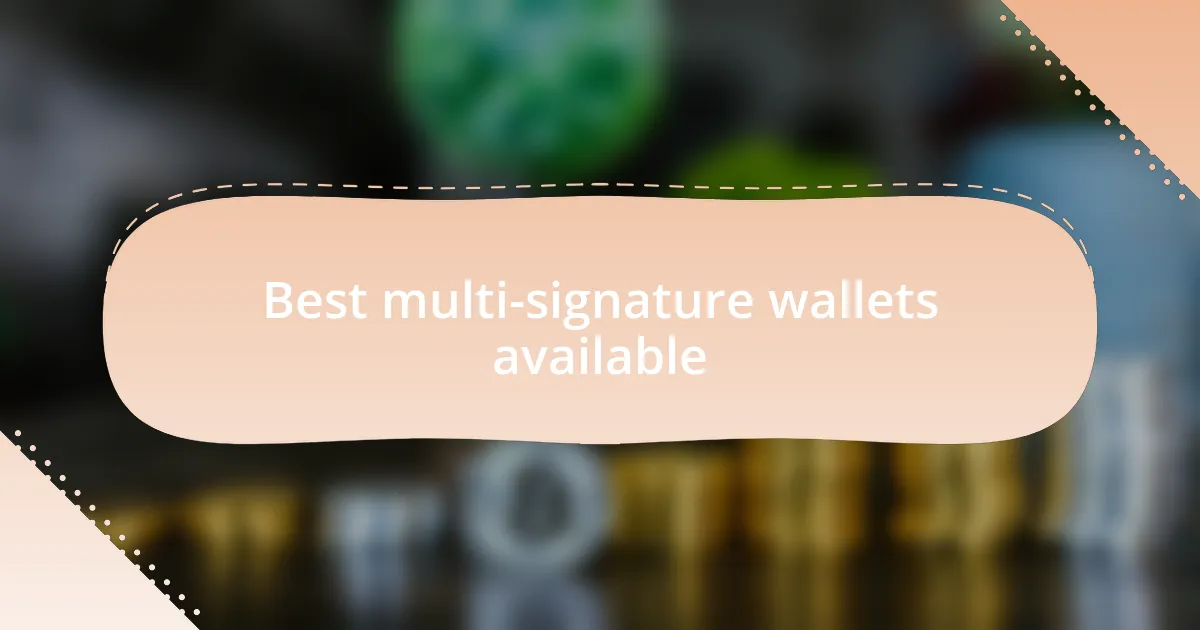
Best multi-signature wallets available
The landscape of multi-signature wallets is rich with options, and a few stand out for their unique features. For instance, Exodus is often praised for its user-friendly interface and seamless integration with multiple cryptocurrencies. When I first tried it, I felt like I had a mini investment hub in my pocket. It’s fascinating how a wallet can change the way you feel about managing assets, isn’t it?
Another strong contender is BitGo, which offers enterprise-grade security for larger operations. The first time I encountered BitGo, I was really impressed by its capabilities for institutional investors. There’s something quite reassuring about knowing that your digital assets are safeguarded with advanced features like insured custody. Wouldn’t you agree that feeling secure is essential when dealing with significant investments?
For those seeking a more code-savvy solution, Electrum should be on your radar. I remember diving into Electrum’s features and appreciating how customizable it is, which appealed directly to my technical side. Its appeal lies in the ability to create customized configurations that fit your needs perfectly. Have you ever considered how much more control you might feel when you tailor your wallet to your specifications? It’s this kind of personalization that can really enhance your cryptocurrency experience.

Common mistakes to avoid
One common mistake I often see is overcomplicating the multi-signature setup. When I first got involved, I wanted the most robust configuration possible. However, this can lead to confusion and difficulties accessing your funds. Keeping it simple, especially if you’re new to this technology, can save you a lot of headaches down the road.
Another pitfall is neglecting to regularly update your security practices. In my experience, I once overlooked an update that would have patched a vulnerability. This taught me how quickly things can change in cryptocurrency. Are you staying up to date with the latest security measures? Ignoring those updates could put your assets at risk.
Finally, I’ve noticed many users fail to communicate effectively with all signers. A lack of clear protocols can create chaos, particularly when multiple people are involved in the wallet’s management. When I first set up a multi-signature wallet with friends, we didn’t establish a clear understanding of our roles, and it quickly led to confusion. So, how can you prevent this? Setting up a communication plan and delineating responsibilities among signers is crucial for smooth operations.
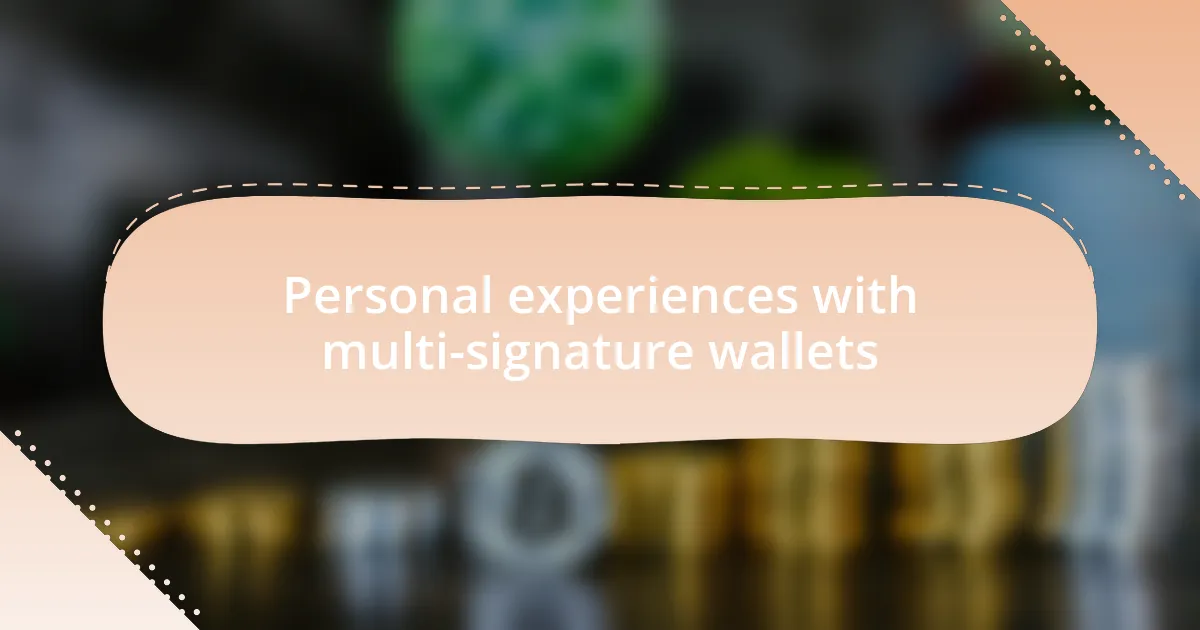
Personal experiences with multi-signature wallets
When I first experimented with multi-signature wallets, I was honestly both excited and nervous. The prospect of enhanced security gave me peace of mind, yet I quickly realized how critical it was to select trusted co-signers. There was one instance where a co-signer didn’t respond in time for a crucial transaction, and it made me realize just how dependent I was on others. Have you ever felt anxious waiting for someone else to give the green light?
In another experience, I decided to set up a multi-signature wallet for a community fund I was managing. Initially, the process felt overwhelming because I wanted everyone to be involved, which led to overly complex arrangements. Eventually, I simplified things by clearly defining responsibilities, and it truly transformed our collaboration. Have you ever felt the need to strike a balance between security and ease of use?
Most striking was the moment I encountered my first issue: one of my signers lost access to their authentication method. Panic set in as we navigated how to recover access without losing funds. It was then I appreciated the need for contingency planning. Have you thought about what you would do in a similar situation?